
Heather Paris (2003) ''Lifting up the Little Form': Victorian Images of Childhood and Death 1870-1900'
Sociological Research Online, vol. 8, no. 3, <http://www.socresonline.org.uk/8/3/paris.html>
To cite articles published in Sociological Research Online, please reference the above information and include paragraph numbers if necessary
Received: 12/11/2002 Accepted: 21/7/2003 Published: 31/08/2003
 Abstract
Abstract Background
Background
 Introduction
Introduction 1. The Visual Representation of Child Death
1. The Visual Representation of Child Death
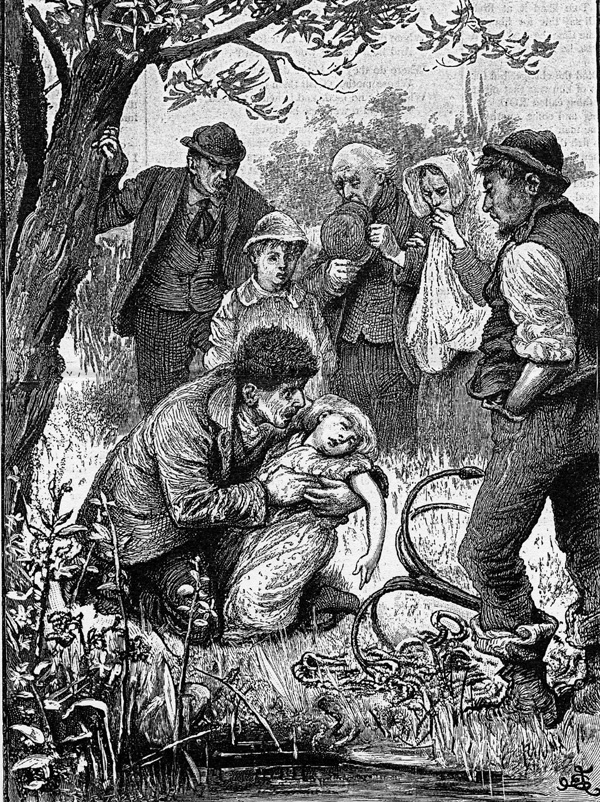
|
| Image 1 |
appeared in The British Workman in 1892. Close to the edge of a river or lake, a horrified man clutches the inert body of a little girl, surrounded by four stunned adults and an older boy in a smock. That this is a depiction of death is confirmed, to a lesser extent, by the lowered hat of the old man and the old woman's pinafore approaching her eyes; but most of all, the spectator's eye cannot avoid the hook and rope used to retrieve the child from the water. The child's body is positioned between the man's arms and the steel arms of the drag hook, between safety and disaster. That two of the men have not removed their hats indicate this is the moment after her retrieval, almost before the horror has sunk in. I know of no other Victorian image quite as explicit as this one in its efforts to convey the actuality of a child recently dead. This was achieved without the depiction of injury to the victim, without facial contortion, and with little disturbance to the child's hair or clothing. These omissions are entirely typical of Victorian pictured childhood, even where evidence of violence, neglect and abuse might be expected by modern viewers.
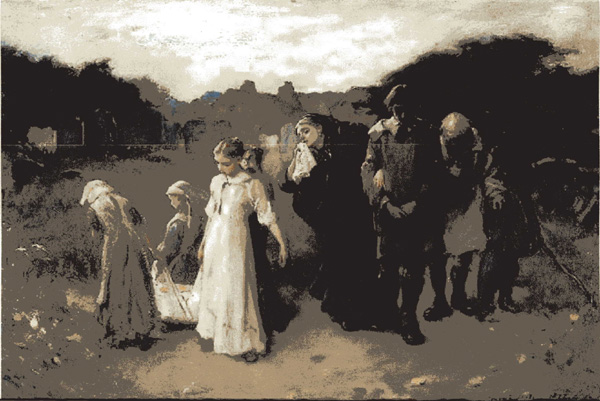
|
| Image 2 |
In a rural churchyard, the gravestones are set well back from the village girls who carry the coffin on the left of the foreground and the grieving parents with their family on the right. The light tone of the coffin is echoed in the girl pall-bearer's dress and the mother's handkerchief. The family seem to walk in darkness towards the spectator, past the coffin's final resting place. This image may depict what was known as a "walking funeral", a tradition of communal burial and mourning since the sixteen hundreds, which John Gillis describes as continuing into the twentieth century.[9] If this is accepted, the young women carrying the coffin are contributing to the efforts of the whole community to support the family in its loss. This contrasts with the painting's title - with its emphasis on the grief of the mother - which seems to draw upon a more middle-class, individualistic cultural tradition.
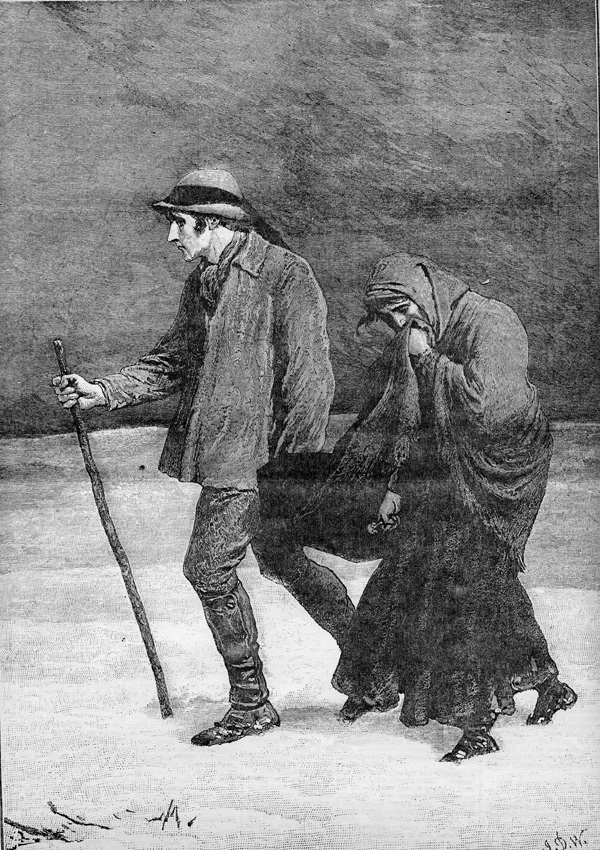
|
| Image 3 |
Although this images shares the lack of officiating clergy with Her first born, they are otherwise very different.
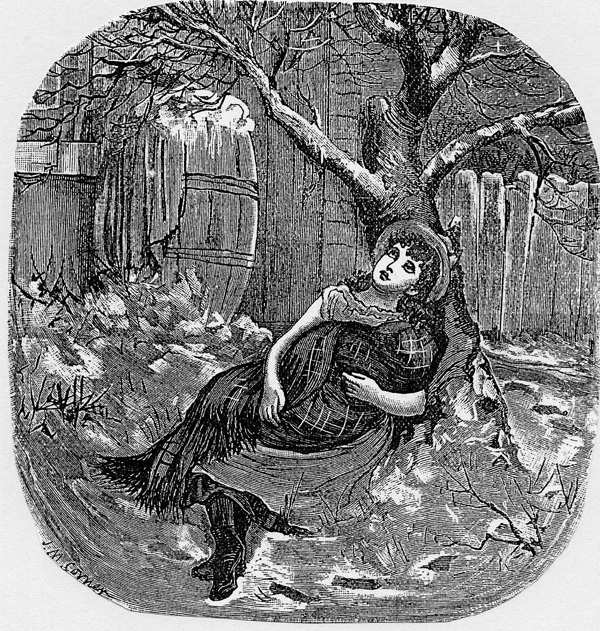
|
| Image 4 |
This is a wintry garden scene, with some dissonant features in it. A girl with bare arms, boots and a hat sits propped against the trunk of a leafless tree. As if to emphasise the cold at work on her bare flesh, the child in her arms is entirely swaddled in what looks like a blanket, while the snow collects on the frozen water barrel. I know of only one other image from the child rescue movement which captures the same stillness of pose and seeming indifference to the cold. In both cases, the indifference comes from death. There were plenty of images depicting barefoot orphans in the snow, but these children usually engaged with the spectator or with adults within the picture frame, selling flowers, offering to sweep the crossing, or begging a few pennies. The tract story explains how parental neglect by a drunken father leads to the death of the child. In textual terms, the theme of "Locked out" is much the same as 'Lifting up her little form'. Even though the text leaves no room for doubt, the tract image leaves just a little scope for optimism in viewers that the girl is not yet dead and every hope that the wrapped child has survived. Compared to this possibility, the finality of 'Lifting up her little form' is incontrovertible.
 2. Pictures about Child Death
2. Pictures about Child Death
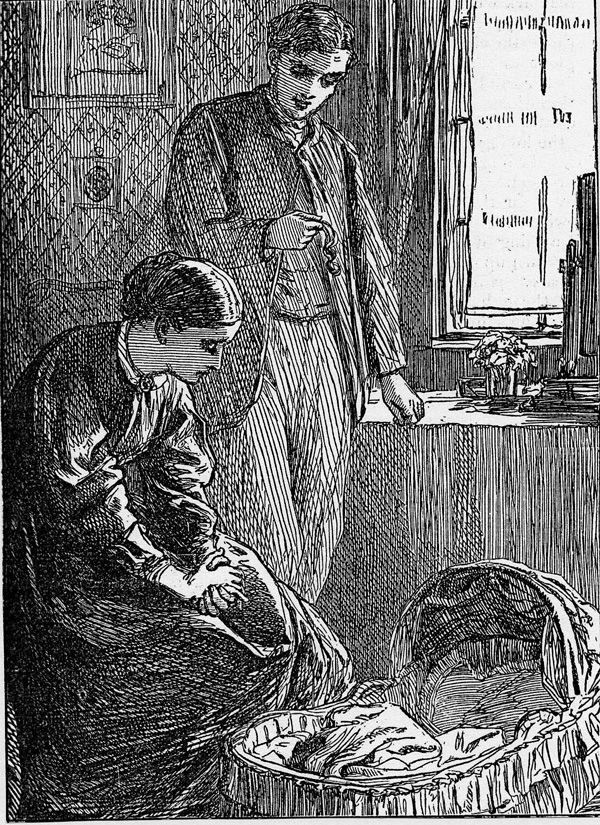
|
| Image 5 |
A man and a woman are pictured in a domestic interior. The seated woman clasps her hands and lowers her eyes to the cradle below her. The bedding in the cradle is drawn back, rumpled, as if the child has only just been removed. The man stands behind the woman and the cradle. His attention might be on the lock of hair he holds in one hand. The hair is probably from the head of his child, now dead. This is all he has left of his child. It is the immobile intensity of the parents - their concentration upon the absence of the baby - which conveys the atmosphere of grief over a death.
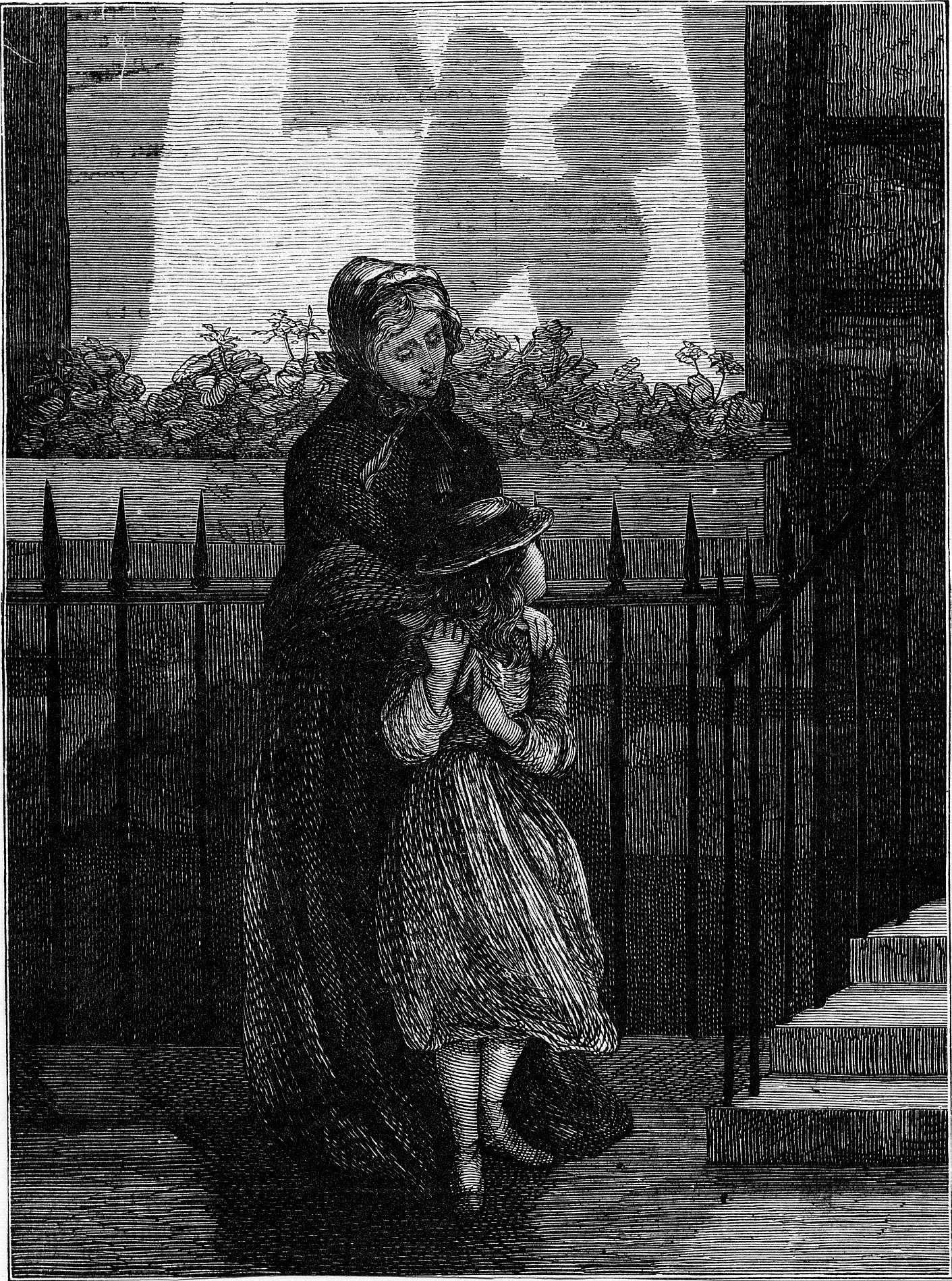
|
| Image 6 |
'Look at this picture' invites the editor of The Children's Advocate for 1872, under a front-page story titled 'Adoption'. 'See the woman and her little child in the cold street', he continues, 'dark but for the ... light that streams out on it, warm and pale from pleasant rooms ...'.[18] Ostensibly, safety is pictured here as the warm, light indoors, danger as the cold, dark urban outdoors. A cloaked young woman rests her hands on the shoulders of a girl, who turns her head to look through the lighted window behind them. Behind the blinds shading the window, a woman lifts up an infant in front of a tasselled lamp- shade. The spectator might have looked at the picture and wondered how it could be connected with the subject of adoption. Was one of the children's mothers about to die, and if so, which of the children will become adopted? The pictorial evidence - and the opening paragraphs of the narrative - strongly suggests death will come to the parent in the street. Light and warmth in the visual representation of childhood was habitually associated with safety.
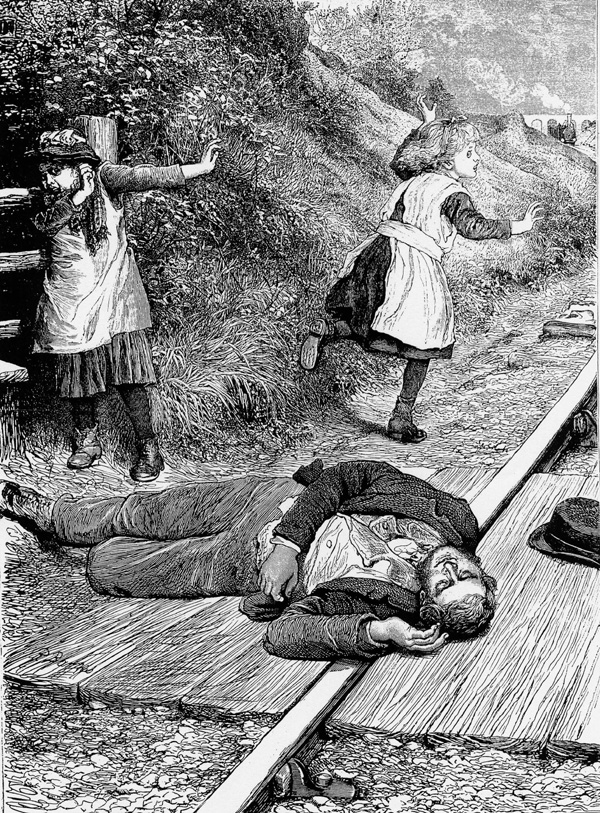
Indeed, this image from The British Workman for 1885 carried a sub-caption "Stop! Stop! Or you'll kill my daddy". In the foreground, a man lies across a railway line. Behind him, one child screams and hides her eyes from the approaching train with a futile, warding-off gesture. Another child, also a girl, runs away from the man on the tracks towards the train. An undifferentiated spectator - one who had never read the journal before - would be likely to conclude that although the child was in some danger, she was not as close to death as her father. He is obviously too heavy for the girls to move, perhaps he is dead already.
 3 The Pictured Child and Adult Mortality
3 The Pictured Child and Adult Mortality
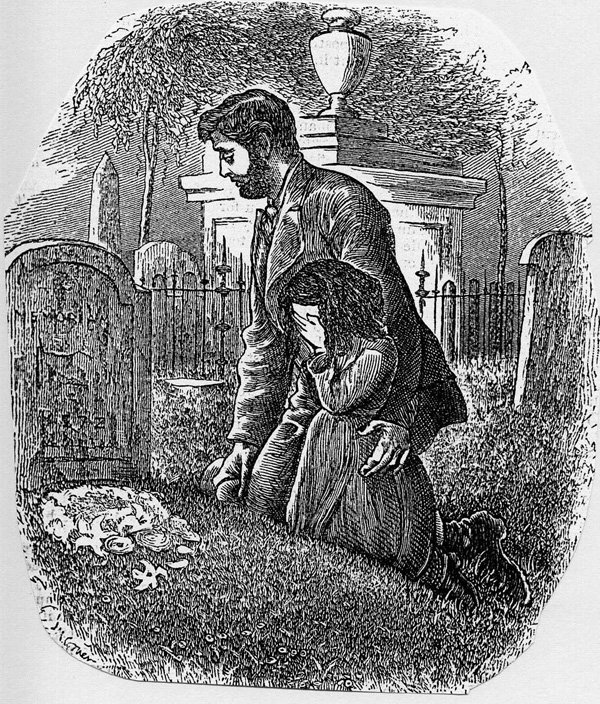
This tract drawing depicts a man and girl kneeling beside a grave that has grass growing on it. This would suggest that the dead person they grieve for died some time before. This adds an enduring component to their grief, perhaps even - in present day terms - its lack of closure. The use of an image at the start of a temperance document conveyed an intended meaning to its audience that the pictured death - as well as causing great sadness - was avoidable, regrettable, and related to alcohol in some way. This is hinted at in the information immediately below the tract's title, beneath the image. This told readers that 'A faithful witness' was written by the author of "The Wife's Remorse" and "Lost for Pride". In this way, grief was associated with different moral strictures. For this audience, therefore, a predisposition would have existed to interpret pictures of death in terms of moral decisions and choices in life.
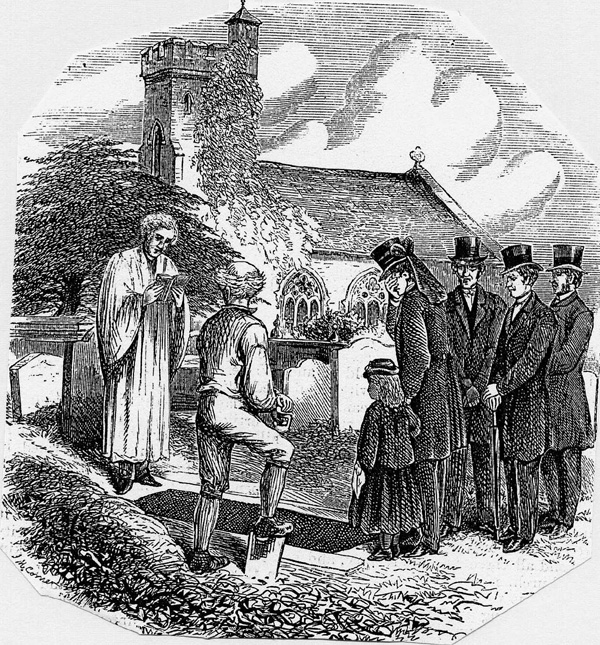
|
| Image 9 |
It accompanies an 1869 tract story called 'Oakhurst Rectory'. All of the participants in the funeral are standing, making the smallness of the girl even more marked. Indeed, she is only as tall as the sexton's spade. The size and scale of the pictured child usually increased the emotional tension in any visual drama, and the picture accompanying this tract is no exception. In this way, the bringing together of childhood and death could convert scenes of mortality into pictures of tragedy. The 'cold, dark depths' of the open grave in this story not only deprived the husband of his wife and the child of her mother, they also 'swallowed up a whole argosy of life's richest hopes and aspirations.'[22]
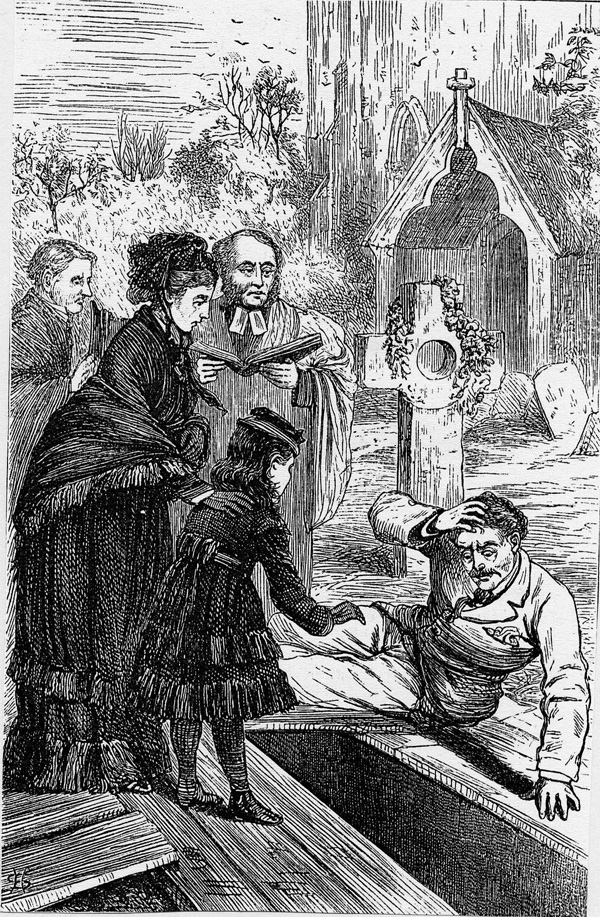
|
| Image 10 |
The caption beneath this image tells readers how 'with a wild cry he flung himself down on the margin and looked in at her coffin'.[23] Even without this textual guidance, it is obvious from the picture that the man was not dressed for a funeral and, by his uncontrolled behaviour, had not expected the death in question. He is brother to the woman, and the burial service is for their mother. The girl does not recoil from him, rather she appears to reach out towards him. Her gesture seems reminiscent of the woman's arm on her shoulder. Indeed, such pictured gestures habitually conveyed to Victorian audiences the comfort an adult would offer to a distressed child. However, the gesture could convey different meanings depending on the age of the person making it. With the exception of the solace felt by a grandparent in the presence of a grandchild, scenes which depicted the child comforter were rare.
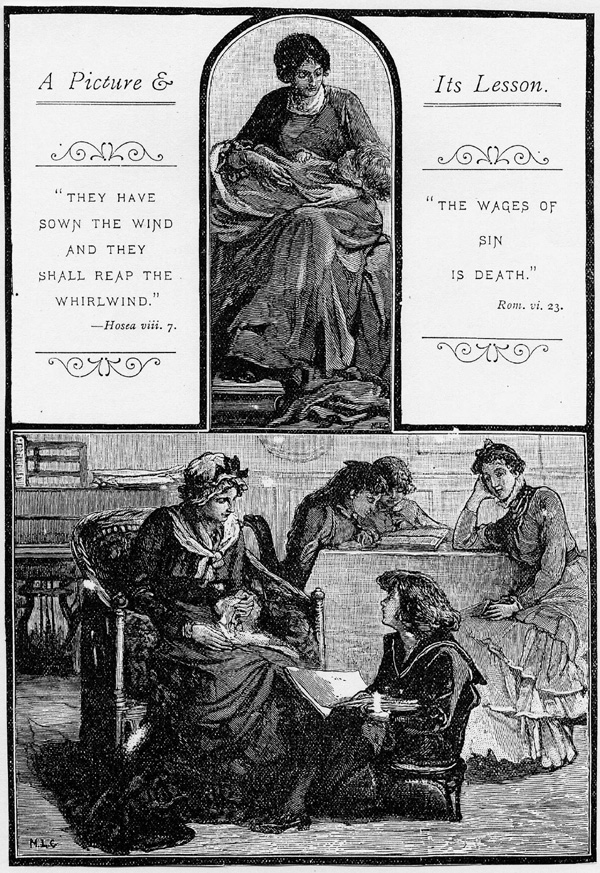
|
| Image 11 |
This image is separated horizontally into two halves and surrounded with a black border. In the top segment, a roman arch reveals a woman with a child in her lap. On either side of the archway, two biblical quotes draw out the relationship between ill-advised action and retribution, and between sin and death. These themes provide an emphatic context to the woman and child, one which converts what might otherwise be a nursing scene to a pieta, usually depicting the Mother of God with her dead son. In a Christian society, it would have been well understood that neither the suffering, dead child, nor the woman, had committed any sin or crime. 'A picture and its lesson', though a secular image, drew from a religious cultural tradition, and the mother and child have been given an everyday, rather than a holy, appearance.
 4. In Conclusion
4. In Conclusion 5. Deceptive Simplicity and its Implications for Sociological Research
5. Deceptive Simplicity and its Implications for Sociological Research Notes
Notes2 See Viviana Zelizer, (1985), Pricing the priceless child The changing social value of children, New York: Basic Books. 'This book focuses on one sociological dimension that has received little attention in the literature: the independent effect of cultural factors redefining the value of children in the US.'(p11) Zelizer refers here to her use of documents from the insurance industry in presenting the value of the child to adults.
3 See John R Gillis, (1997), A world of their own making a history of myth and ritual in family life, Oxford University Press, chapter 10, 'Haunting the dead', pp201-221. Gillis's book describes the largely modern, mostly Victorian origins of family life. His chapter on death argues that the traditional family reunion is more suited to the cemetery, with its emphasis on the eternal, with notions of the domesticated family in heaven, than fast-paced modern life.
4 Diana Gittins, (1998), The child in question, Macmillan Press Ltd, chapter 4, 'What do children represent?'. Gittins gives her own warning about the visual representation of childhood. 'We as watchers' she argues 'do not know the context in which images are constructed, we do not know their history and the net result of this is that their history is denied.' (p110).
5 Gittins, ibid., p11.
6 The statistical picture for infant mortality varied little during the period. The death rate for infants under one year old in England and Wales was exactly the same in 1840 as it was in 1900 and varied little in between. It hovered around 154 per 1,000 live births.
7 The British Workman, (1892), p48.
8 The British Workman, (1892), p48.
9 See John R Gillis, op. cit., pp201-221.
10 The Illustrated London News, (1879) April 26, p386.
11 Rather than contribute to the well-known debate about why and if parents mourned more or less for their children in periods of high infant mortality, I have confined myself to the evidence of contemporaneous commentaries accompanying the visual part of the historical record wherever possible. For a concise summary of the debate see Pat Jalland, (1996), Death in the Victorian family, Oxford University Press, p121. Jalland argues that her findings support the position of Linda Pollock rather than Lawrence Stone. Jalland's chapter 6, "That Little Company of Angels": The Tragedies of Children's Deaths', pp119-142, provides a sound summary of family responses to child death.
12 The Band of Hope Treasury was the magazine of the juvenile temperance movement in the north of England. Bands of Hope were first created in the 1850s to draw in children to life-long habits of temperance thinking. Perhaps more important to campaigners than the child's pledge never to drink alcohol, was the hope that parents and other adults in their family circle would be influenced by children's purity and rectitude.
13 The Band of Hope Treasury, No 23, (1871) November, p102.
14 The Band of Hope Treasury, No 194, (1886) February, p17.
15 See Pat Jalland, op. cit., pp122-124. Jalland also describes how the 1879 publication of the memorial volume on the death of Archbishop Tait's children and his wife was one of the most widely read Victorian books of consolation literature. Tait became Archbishop of Canterbury in 1869; he and his wife wrote heartrending accounts of the deaths, one by one, of five out of their seven children.
16 My maternal grandmother had three sons, two of whom died in infancy. When her second son died in 1917, at the age of one year, one month after the death of her first son, a spiritualist neighbour from the other side of the street came to console her with the news that he was happy in heaven. My grandmother was distressed rather than consoled and my grandfather was furious with the neighbour.
17 For a full description of isolation as an attempt to protect and save the child from contagion see Jalland, op. cit., pp124-134.
18 The Children's Advocate, No 11, (1872) November, title page. The Children's Advocate was the journal of the National Children's Homes, part of the child rescue movement, and was edited by the Homes's founder, the Reverend T B Stephenson.
19 Idem.
20 British Temperance League's Monthly Pictorial Tract No 165, (1879) July, p4.
21 The notion that children encapsulate the idea of the family is not a new one of course. This was very much the approach taken in the classic text by Philippe Aries, (1962) Centuries of Childhood, London: Jonathan Cape.
22 British Temperance League's Monthly Pictorial Tract No 44, (1869) June, p4.
23 Onward, (1875) June 1st, p106. Onward was the journal of the Lancashire and Cheshire Band of Hope Union and first appeared in 1865.
24 Ibid., p109.
25 Onward, (1890), p165.
26 Idem.
27 Gittins, op cit., p111.
28 These pictorial features were repeated elsewhere. A young girl is pictured from behind, so that it is impossible to gauge her expression, in 'Lord Frederick Cavendish lying in state at Chatsworth, 1882', an image which appeared in the Illustrated London News at the time. The girl is barely able to see into the coffin due to her height and its position. She shares this incapacity with the viewer of the image. Two other children, who are nearer the coffin than her, peer out between gentlemen removing their hats. A woman leans over the coffin to lift the linen covering the face of the corpse, to enable mourners to pay their respects.
29 Gillis, op cit., p210.
30 Gillis, op cit., p210.
31 One recent and powerful contribution in this area comes from Anne Higonnet, (1998) Pictures of innocence, the history and crisis of ideal childhood, Thames and Hudson, London. Higonnet sets out a new vision of childhood as the knowing child, rather than the traditional view of the child as a representation of innocence. She asks whether 'we now have to consider whether a child has to be psychically or sexually innocent to deserve protection, or whether social innocence is all the justification we should ever need to shelter children from adult abuse'.(p12) This is a very important question to raise, although I find I am less than comfortable with her observation that '...if latent sexuality now seems reprehensible in pictures of children by men, especially if the children are girls, it can seem empowering in pictures by women.'(p125)
 Acknowledgements
Acknowledgements
Image (2) Her first born, Horsham Church Yard, Frank Holl, 1877, reproduced with kind permission from Sheffield Galleries and Museums Trust.
Image (3) 'A dreary day', The Illustrated London News, 1879, reproduced with kind permission of The Illustrated London News Picture Library.
Image (4) "Locked out", British Temperance League Monthly Pictorial Tract Number 236, June 1885, reproduced with kind permission of The University of Central Lancashire Library.
Image (5) 'The empty cradle', Band of Hope Treasury, November 1871, reproduced with kind permission of The University of Central Lancashire Library.
Image (6) 'Adoption', The Children's Advocate, November 1872, reproduced with kind permission of The University of Liverpool Library.
Image (7), 'What the train brought', The British Workman, 1885, reproduced with kind permission of The University of Central Lancashire Library.
Image (8) 'A faithful witness', British Temperance League Monthly Pictorial Tract Number 165, July 1869, reproduced with kind permission of The University of Central Lancashire Library.
Image (9) 'Oakhurst Rectory', British Temperance League Monthly Pictorial Tract Number 44, June 1869, reproduced with kind permission of The University of Central Lancashire Library.
Image (10) 'With a with cry', Onward, June 1st, 1875, reproduced with kind permission of The University of Central Lancashire Library.
Image (11) 'A picture and its lesson', Onward, 1890, reproduced with kind permission of University of Central Lancashire Library.
